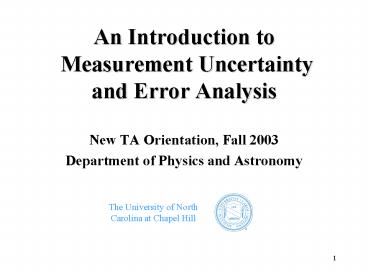An Introduction to Measurement Uncertainty and Error Analysis - PowerPoint PPT Presentation
1 / 16
Title:
An Introduction to Measurement Uncertainty and Error Analysis
Description:
An Introduction to Measurement Uncertainty and Error Analysis New TA Orientation, Fall 2003 Department of Physics and Astronomy The University of North Carolina at ... – PowerPoint PPT presentation
Number of Views:238
Avg rating:3.0/5.0
Title: An Introduction to Measurement Uncertainty and Error Analysis
1
An Introduction to Measurement Uncertaintyand
Error Analysis
- New TA Orientation, Fall 2003
- Department of Physics and Astronomy
The University of North Carolina at Chapel Hill
2
Are these time measurements significantly
different?
- t1 1.86 s
- t2 2.07 s
- Yes
- No
- Cant tell
3
Are these time measurements significantly
different?
- t1 1.86 s
- t2 2.07 s
- Student responses (N 44)
- Yes 43
- No 27 ???
- Cant tell 30
4
Purpose and Challenges
- Science relies on empirical data, which is
inherently subject to measurement error - Uncertainty estimates are necessary for
- assessing quality of data
- comparison of data
- verify/refute theoretical predictions
- Students often have difficulty analyzing errors
- Guidelines for reporting uncertainties vary
- Terminology and notation is not consistent
- International standard exists but is not well
known
5
Student Difficulties
- 1) Uncertainty is rarely estimated and stated,
even when required (true for experts too!). - 2) Even if found, most students do not use
uncertainties to justify their conclusions. - 3) Calculated values are often reported with too
many (in)significant digits. - 4) Students have difficulty identifying the
primary source of error in an experiment.
6
Student Difficulties
- 1) Students often fail to report a quantitative
uncertainty estimate, even when requested. - Overall reporting rates from this study
- 0 to 50 of students reported uncertainty
- 30 to 70 of TAs reported uncertainty
7
Student Difficulties
- Task Use a ruler to measure the diameter of a
penny as accurately as possible.
8
Student Difficulties
- 2) Even if stated, most students do not justify
their conclusions based on the uncertainty - Judgements are made based on arbitrary criteria
- Our percent error was only 4, so our experiment
proved the theory. - I decide by how much two measurements differ in
order to see if they agree. - The result should be accurate as long as the
error is less than 10. - Similar findings in other studies (Sere
Garratt)
9
Student Difficulties
- 3) Students tend to overstate precision
(too many significant figures) of calculated
values and to a lesser extent for directly
measured values.
Typical student values
L
L 2.35 cm ( 0.05 cm) W 1.85 cm ( 0.05 cm)
W
A LW 4.3475 cm2 (Expert A 4.3
0.1 cm2 )
10
Student Difficulties
- 4) Students have difficulty identifying the
primary source of error in an experiment. - Are nickel coins made of nickel? Find density
- Median density from 76 students 7.1 g/cm3
- (standard deviation 10 g/cm3 )
- Density of pure nickel 8.912 g/cm3
- Density of nickel coin 8.9 0.4 g/cm3
- (alloy of 25 nickel, 75 copper)
11
Sources of Error for Nickel Density
12
- Students often focus on the details of error
analysis and miss the big picture, losing sight
of the forest for the sake of the trees.
13
Student t1 (s) t2 (s) 1.86 2.07 1.74 1.89
2.15 2.20 Average 1.92 2.05
t1 (s) t2 (s) Std. Dev. 0.21 0.16 Std.
Error 0.12 0.09
The numbers are close, but
different.
Expert
These time measurements agree with each other.
14
Teaching Tips
- Remind students of the big picture view of why
uncertainty estimates are important. - Show examples of how to decide whether results
agree or disagree within their uncertainty using
error bars on number line. - Require students to justify their conclusions
based on uncertainty estimates, no general
statements like - Our results only had a 5 error, so this proved
the theory. - wrong, for more than one reason! - Teach concepts consistent with ISO Guide
15
ISO Guide to the Expression of Uncertainty in
Measurement (GUM)
- International Organization for Standardization
published new guidelines in 1993 for industry and
research - NIST version physics.nist.gov/cuu/Uncertainty
- Use standard uncertainty
- Type A component random, evaluated
statistically - Type B component systematic, judgement, a
priori - use terms uncertainty and error appropriately
- explain meaning of notation and uncert. value
16
It is better to be roughly right than precisely
wrong.
- - Alan Greenspan
- U.S. Federal Reserve Chairman
For more on measurement uncertainty research, go
to www.physics.unc.edu/deardorf/uncertainty































